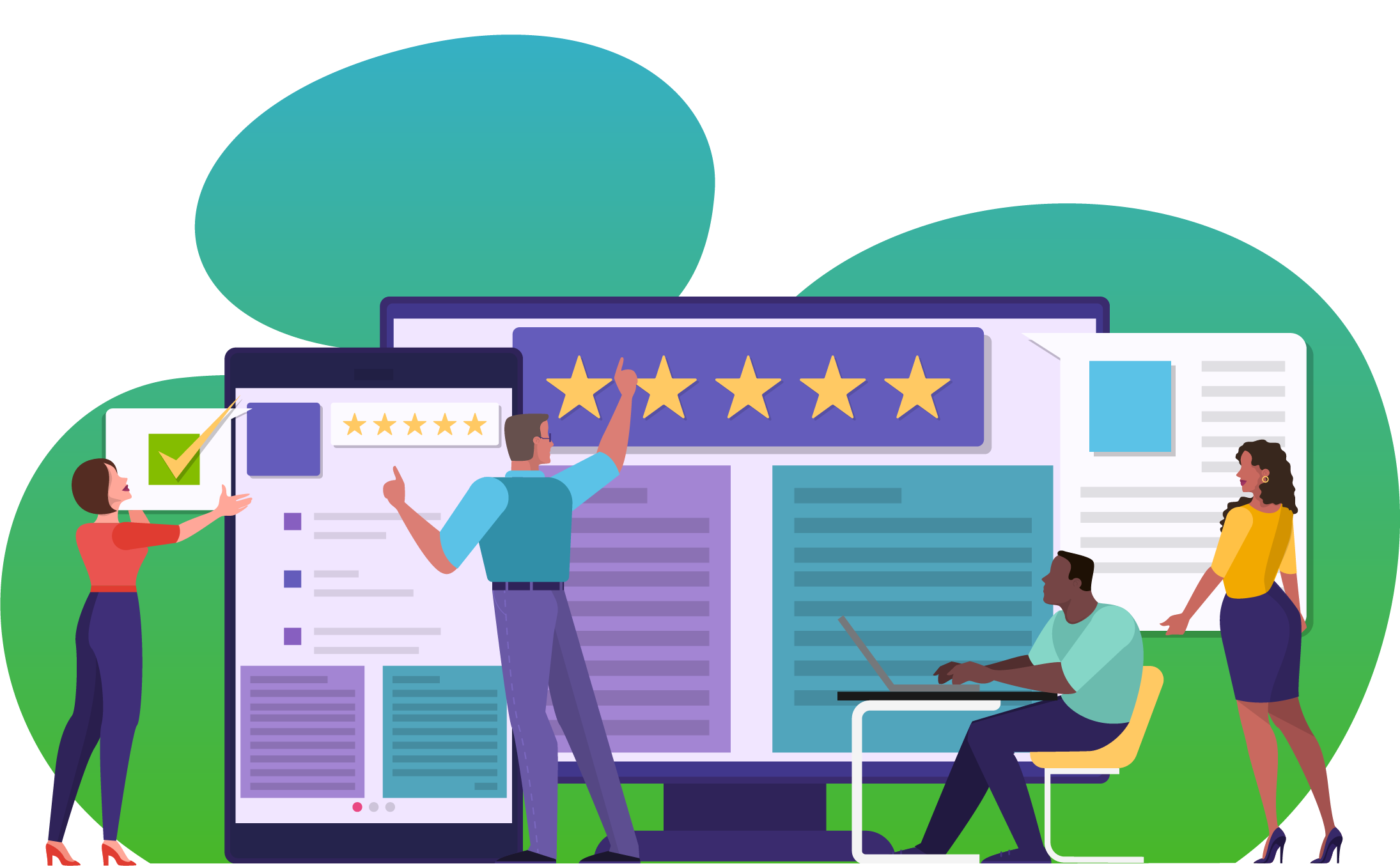A comprehensive breakdown of how various components of user-generated content impact conversion rates, based on an analysis of 1.5MM online product pages from over 1,200 brand and retailer sites during 2021.
Research at a Glance:
The Conversion Impact of User-Generated Content: The Complete Breakdown for 2022 is based on an analysis of 1.5MM online product pages from over 1,200 brand and retailer sites throughout the course of 2021 (and is an update of the previous version of this same research). Here’s a snapshot of our key findings.
- There’s an 8.5% increase in conversion among visitors who are served up some form of UGC on product pages.
- The conversion lift is significantly larger – 100.6% – among visitors who interact with the UGC in some manner.
- Visitors who interact with ratings and reviews convert at a rate that’s 108.3% higher than average.
- Specific review features lead to even larger conversion lifts, including Helpful Yes votes (414.3%), Helpful No votes (292.9%), and Review Search (260.7%) – among others. We’ve included examples of these features in action later on in this report.
- 61.6% of visitors who interact with star rating filters specifically filter to see one-star reviews. These visitors still convert at a rate that’s 85.7% higher than average, proving that negative reviews aren’t conversion killers.
- In 2021, there was a 194.2% lift in conversion among visitors who interacted with Q&A content, making it the type of UGC that impacts conversion most. This is up significantly from a 157.1% conversion lift among Q&A interactors in 2020.
- Q&A features that have a particularly high impact on conversion include Show More Answers (217.9%), Click Read Answers (192.9%), and Answer Helpful voting (192.9%). Later on in this report, we’ll share real-life examples of each.
- There is a 106.3% lift in conversion among visitors who interact with user-generated imagery on a product page, up significantly from a 91.4% lift in 2020.
- Imagery interactions that are particularly impactful on conversion include clicking on the image gallery (110.7%), clicking to view the next image/video (103.6%), and clicking to see the previous image/video (96.4%)
- When it comes to displaying UGC on your product pages, best practices are a great place to start. However, there’s no “right” way to do it.
- Instead, analyze your UGC performance regularly and then optimize your strategy accordingly.
Introduction
UGC Has Become an Expected Part of the Purchase Journey
When consumers are researching products and services, they’re no longer satisfied to hear from the brands and retailers that sell them. Instead, they want to hear from the real experts: those who have purchased and used the product or service in question.
In fact, user-generated content, including ratings & reviews, questions & answers, and visual content has become an essential component of the shopping journey for modern consumers. If there’s any doubt in your mind, consider these statistics:
But What’s the Conversion Impact of UGC?
Collecting and displaying user-generated content is an important way to meet shoppers’ expectations. However, before investing in UGC, brands and retailers (understandably) want to know what’s in it for them. In other words, how does the presence of this content impact one of their most important metrics: conversion?
Now, we have a definitive answer.
We analyzed activity on over 1,200 brand and retailer sites over the course of 2021 to pinpoint the conversion impact of three key types of UGC: ratings & reviews, Q&A, and visual content. We also examined how that impact has changed in the year since our last analysis.
Of course, each UGC display is different. While a visually appealing, on-brand UGC display is typically a priority for many, the ultimate aim must be to create a display that has the greatest conversion impact. For this reason, we have examined how specific features of each type of UGC impact conversion.
Measure and Optimize UGC Regularly to Unlock the Biggest ROI
While understanding how UGC elements impact conversion is important, it’s only the beginning. That’s because each business is different. And while one feature may be particularly impactful for some brands and retailers, it might not be as effective for others.
Ultimately, you’ve got to determine what works best for your business.
Start with best practices, and test new features and functionality that are shown to impact conversion. Then, measure your UGC performance on a regular basis and use those insights to optimize your UGC display for even better results.
Methodology & Definitions
This report is based on an analysis of 1.5MM online product pages from over 1,200 brand and retailer sites over the course of 2022. Here is a key of terminology to refer back to when reading the report:
A High Level View of How UGC Impacts Visitor Conversion
The Mere Presence of UGC on a Product Page Positively Impacts Conversion
During 2021, there was a 2.8% conversion rate on the 1,200 sites we analyzed that run PowerReviews’ UGC technology.
This may be slightly higher than benchmarks you’ve seen from other sources. There are a couple reasons for this variance.
- We base conversion on visitors rather than sessions. See above for more information on our methodology.
- Assuming the PDP is built this way (which most are), all shoppers in the sample we analyzed are served up some form of UGC above the fold. Typically, this is a summary that includes average star rating and review distribution. Again, see the methodology section for more details on what we classify as a UGC impression or UGC interaction.
When a visitor scrolls to a point where they see some form of UGC, they’re more likely to convert. In fact, there’s an 8.5% lift in conversion when a visitor is served up some form of UGC. In comparison, UGC impressions resulted in a 4.3% lift in conversion in 2020.
UGC Interactions Significantly Boost Conversion
When site visitors actually interact with UGC, the impact on conversion is even more significant. There’s a 100.6% lift in conversion among those who interact with UGC, down slightly from a 108.4% lift in 2020.
We’ll dive deeper into how consumers interact with UGC throughout this report.
By simply displaying UGC (including reviews, Q&A and visual content) you can experience a notable lift in conversion. However, UGC interactions drive an even larger impact.
How Review Interactions Impact Conversion
Reviews Double Conversion Rates
It’s no secret that a growing portion of consumers are shopping online – a trend that is unlikely to slow down. Statista forecasts that ecommerce will make up nearly a quarter of total retail sales worldwide by 2025.
While online shopping is convenient, it also involves a level of risk. That’s because it’s impossible to know for certain that a product will fit one’s needs – especially without seeing it in person first.
Reviews can help shoppers overcome this risk and increase their likelihood of making a purchase. There’s a 108.3% lift in conversion among visitors who interact with reviews.
The Impact of Various Review Features on Conversion
Helpful Votes
While some reviews are helpful when a shopper is making a purchase decision, others simply aren’t. A visitor can indicate if a given review is helpful (or not) by clicking on the thumbs up or thumbs down icon.
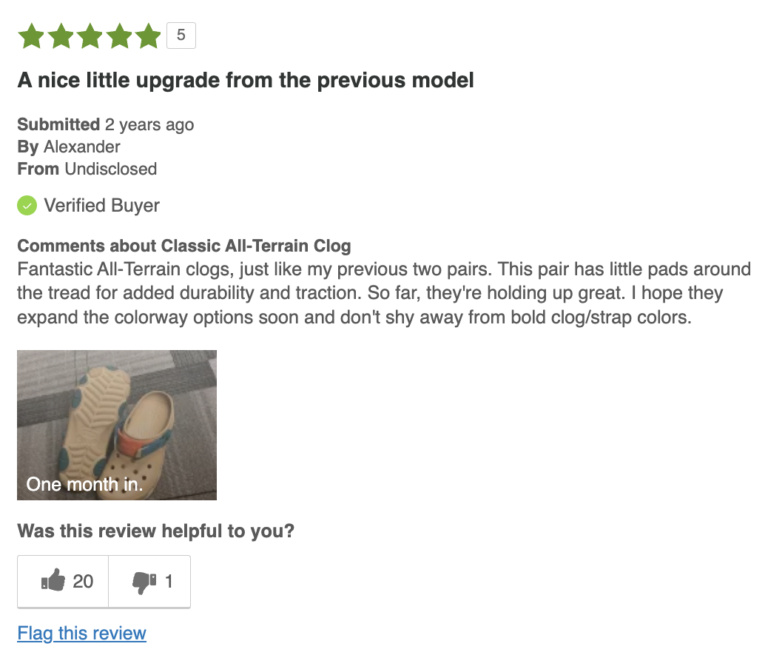
Helpful voting is the review interaction that impacts conversion most. There’s a 414.3% lift in conversion among visitors who click the thumbs up icon. In comparison, there was a 314.7% lift in conversion as a result of this interaction in 2020.
Interestingly, there’s also a large conversion lift – 292.9% – among visitors who click the thumbs down icon on a review. While a specific review might not be particularly helpful, it doesn’t necessarily deter a shopper altogether.
Review Search
Typically, a consumer doesn’t read every single review for a given product. Instead, they seek out content that’s relevant to them. One way they can do this is by typing a search term into the review search box.
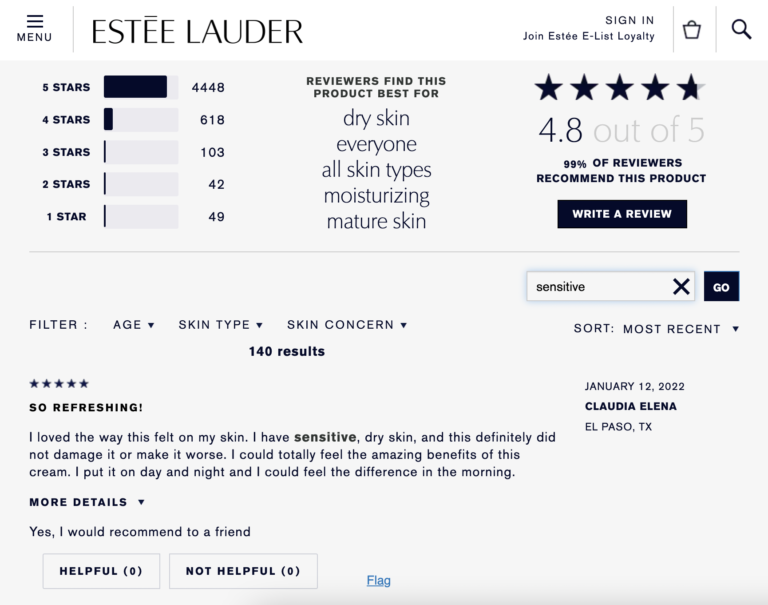
There’s a 260.7% lift in conversion among visitors who interact with the review search feature, up from 202.9% among those who took this action in 2020.
Footer Page Actions
Once a visitor has scrolled to the bottom of a review display, they have the opportunity to take a few different actions. They can go to the next page of reviews, return to the previous page, or return to the top.
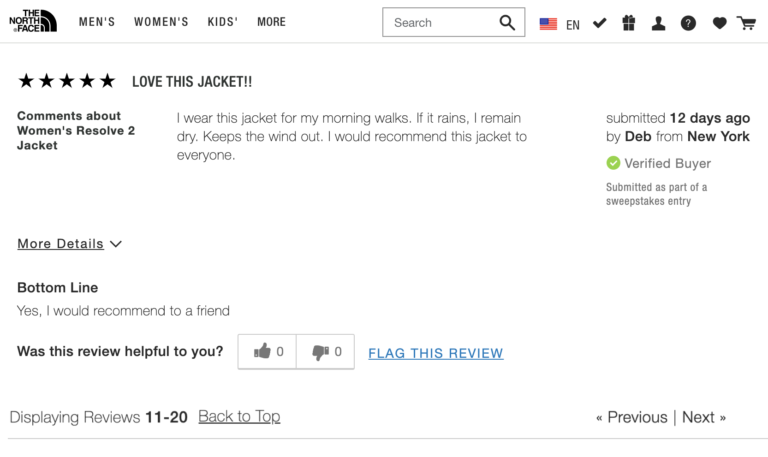
Here’s a snapshot of how these footer actions impact conversion – both in 2020 and in 2021. Notably, “back to top” is the footer action that’s garnered the largest year-over-year lift in conversion.
Review Snippet
It’s considered a best practice to display a review overview (also known as a snippet) at the top of product pages. The snippet provides a high level overview of the review content for a product and typically includes information such as the average star rating and the number of reviews available for the product.
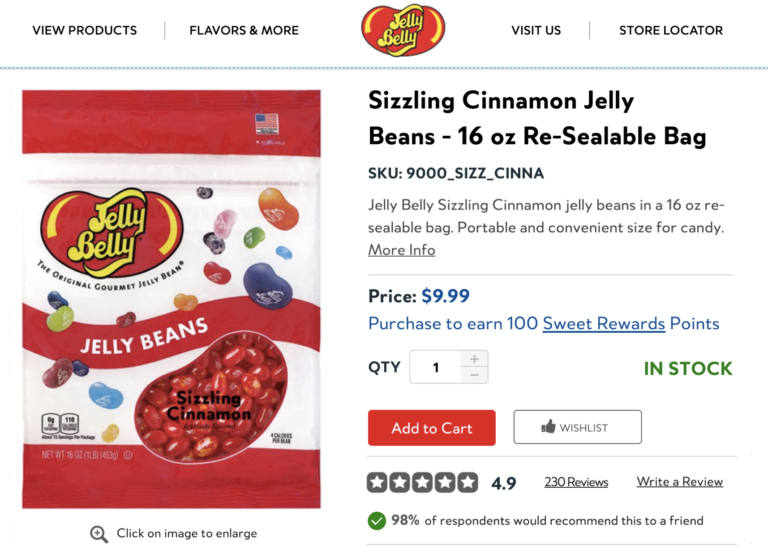
If a visitor clicks on the snippet, they’re taken to the full review display, where they can read individual reviews, as well as sort and filter content to find what’s most relevant to them. There’s a 164.3% conversion lift among consumers who click the review snippet, up from a 129.4% lift in 2020.
Review Faceoff
Some brands and retailers display a product’s most liked positive review alongside its most liked negative review one. This is referred to as a review faceoff, and it’s a great way for shoppers to quickly determine the best case and worst case scenarios of a given product.

There’s a 128.6% lift in conversion when shoppers click to read the entire positive review that’s featured in the snapshot.
What’s perhaps more interesting is that there’s a 114.3% lift among shoppers who click to read the entire negative review. This is proof that negative reviews don’t necessarily deter shoppers. Instead, this content allows consumers to understand the worst case scenario of a given product. If it’s something they can live with (or that simply isn’t relevant to them), they’re still likely to move forward with the purchase.
Review Sorting
The best review displays allow visitors to easily sort reviews to surface what matters most to them. For example, a visitor might sort content based on recency, helpfulness, or the availability of visual content.
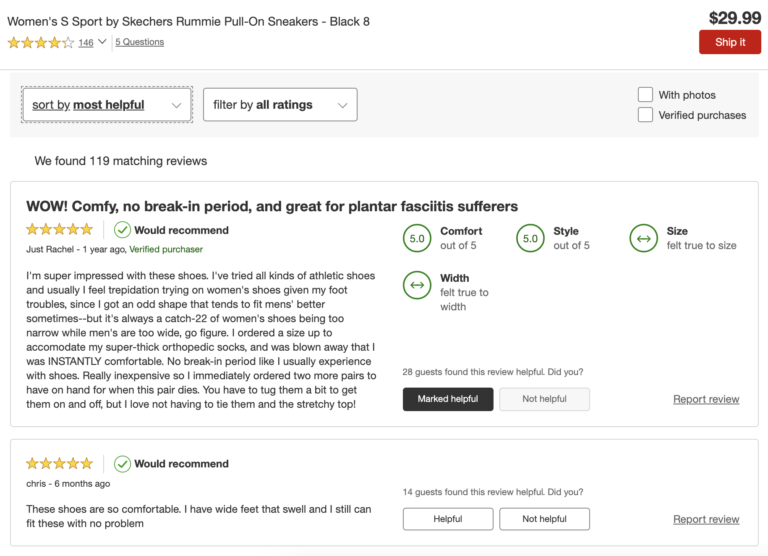
There is a 114.3% lift in conversion among shoppers who click to sort reviews. This is up slightly from 2020, when there was a 109.7% conversion lift for this type of interaction.
Here’s a closer look at how different types of sorting behavior impact conversion – both in 2020 and 2021.
Star Filters
Many brands and retailers include a feature in their review display that allows shoppers to see how many reviews were written for each star rating. Shoppers can then click on a specific star rating – and just the content submitted with that particular rating will be displayed.
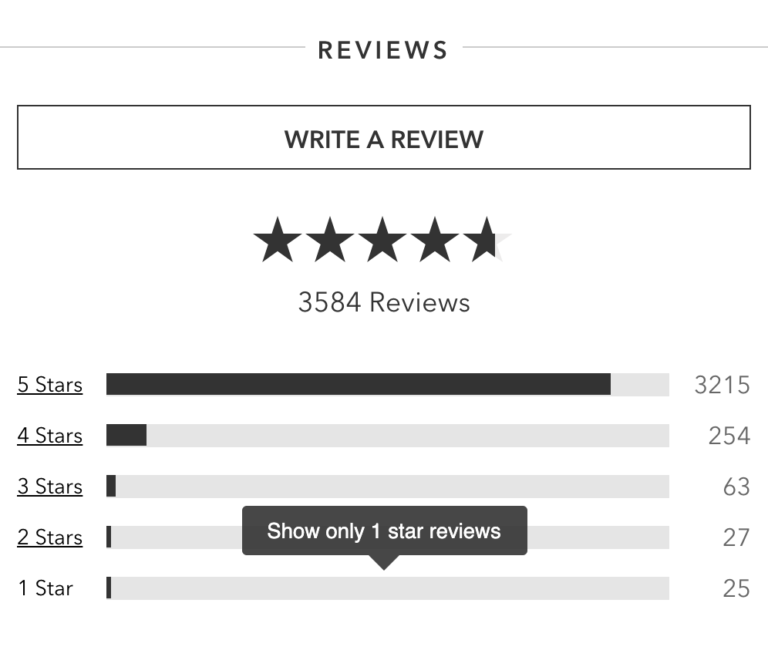
There’s a 89.3% lift among shoppers who click to filter by star rating.
Let’s zoom in further to see how many visitors filter reviews by each star rating – and how it impacts conversion.
The most common way to filter by star rating is to see only one-star content. This isn’t surprising, as previous research found that 96% of consumers specifically seek out negative reviews – with over half (52%) explicitly looking for one-star content.
What is surprising is that those who filter to see one-star content still convert at a rate that’s much higher than average. In fact, there’s a 85.7% lift in conversion among those who filter to see one-star reviews. Again, this is proof that the presence of negative reviews isn’t enough to deter many consumers. Rather, negative reviews are a tool that consumers depend on to make more informed purchase decisions.
Filter Tags
Some brands and retailers ask those writing reviews to select “tags” related to the product. These might include pros, cons and best uses of a product – among others.
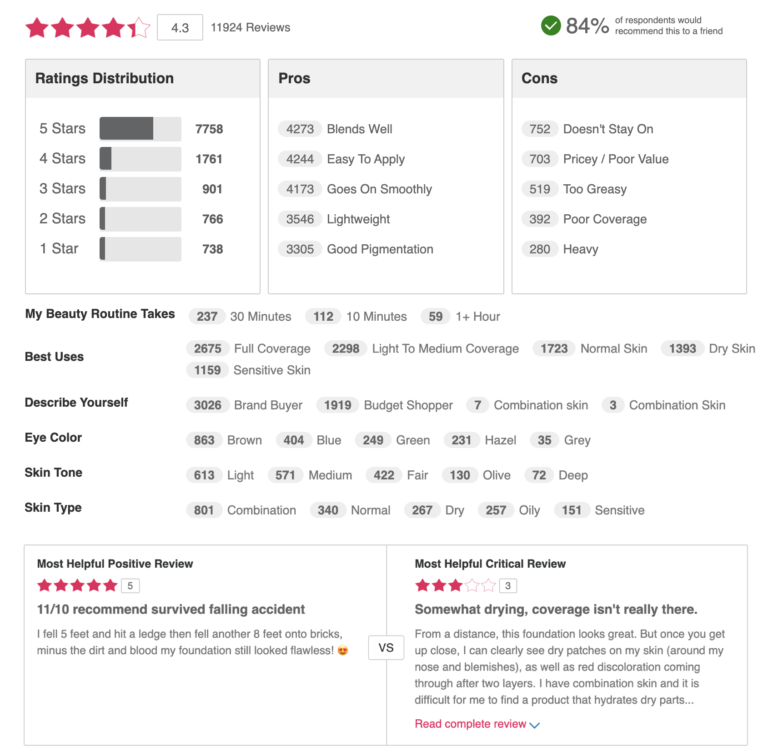
These brands and retailers then allow future shoppers to filter reviews by these specific “tags.”
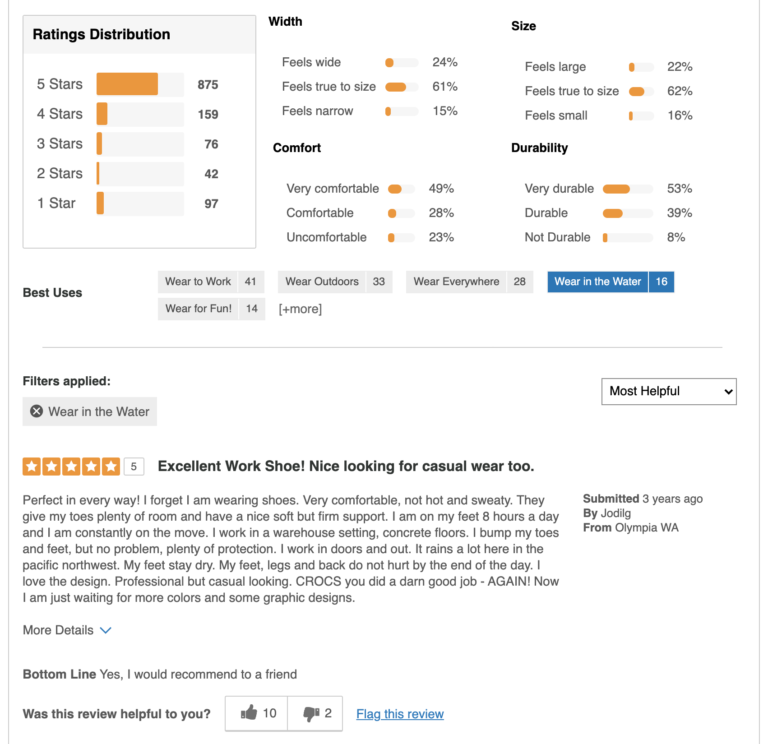
Visitors who filter reviews by tags convert at a rate that’s 78.6% higher than average. This is up significantly from 2020, when there was a 35.3% conversion lift among visitors who filtered reviews by tags.
More Details
When a visitor is reading a review, sometimes they have the opportunity to expand it to get additional details about the shopper that wrote the review and their experience with the product.
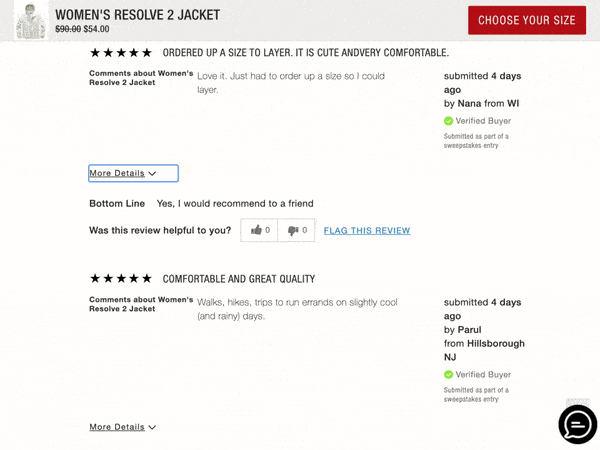
There’s a 50% lift in conversion among shoppers who click to expand a given review to read more details.
The Growing Impact of Q&A Interactions on Conversion
When a consumer is shopping in a store, they can reach out to a sales associate to ask questions and get product recommendations. That’s not possible for online shoppers.
Instead, many of these consumers scroll the product page to find the questions and answers (Q&A) portion of the page. There, they can see if other shoppers have already submitted similar questions – and gotten answers. If not, they can submit their own.
Q&A Continues to be the Most Impactful Kind of User-Generated Content – And its Impact is Growing
When we analyzed 2020 data, we found that of the types of UGC, Q&A had the largest impact on conversion.
This continues to be the case. In fact, the impact of Q&A on conversion continues to grow. In 2021, there was a 194.2% lift in conversion among those who interacted with Q&A content, up significantly from a 157.1% conversion lift in 2020.
Many Types of Q&A Interactions Positively Impact Conversion
A typical Q&A display includes various features and functionality. Let’s examine how interacting with key features impacts purchase behavior.
Show More Answers
On a typical product page, a set number of questions and answers appear. If there is more Q&A than what is initially displayed, the shopper can click on text that reads “Show more Q&A” to access it.
If a shopper seeks out additional Q&A beyond the content that’s initially displayed, it’s clear they’re interested in learning a lot about a given product. They’re also more likely to convert. In fact, there’s a 217.9% lift in conversion among shoppers who click “Show more Q&A.” This is up significantly year-over-year. In 2020, there was a 164.7% conversion lift when shoppers clicked to show more Q&A.
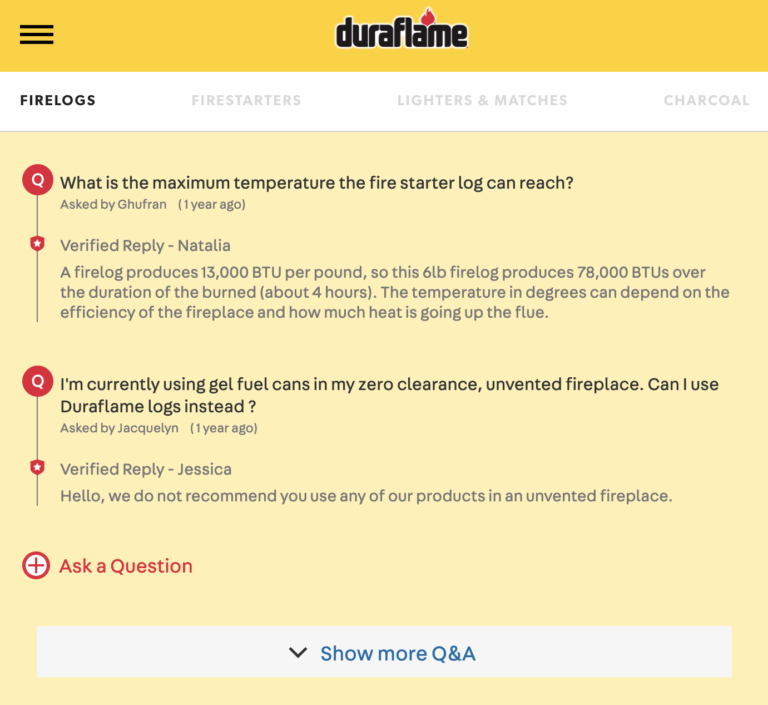
Click Read Answers
By default, a single answer is usually displayed for a given question submitted via Q&A. However, there are instances when there might be multiple responses to a single question. For example, a question might have an official response from the brand, as well as from someone who purchased the product. The visitor can click “show more answers” to see any additional responses.
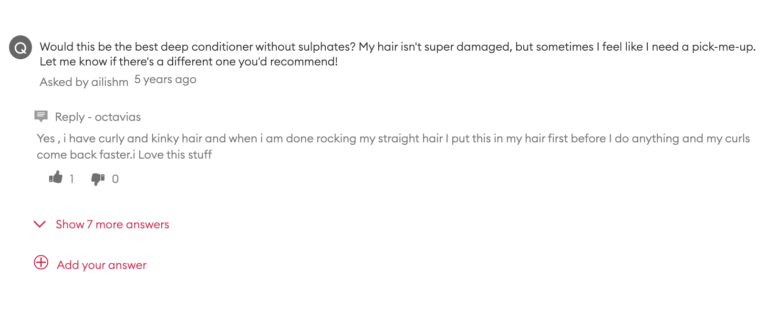
There’s a conversion lift of 192.9% among visitors who click to show more answers. In 2020, the lift for this action was 158.8%
Answer Helpful
If a shopper finds a response to a previous customer’s question to be particularly helpful, they might opt to tap or click the thumbs up icon.
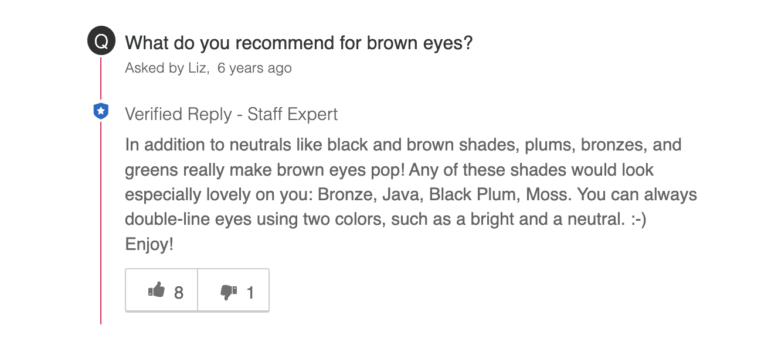
Those who click the helpful icon convert at a rate that’s 192.9% higher than average. This is up significantly from 2020, when there was a 141.2% lift in conversion among visitors who took this action.
Answer Question
Our previous research found that 94% of shoppers value answers to Q&A that are posted by verified buyers who have already purchased the product in question. So it’s not surprising that a growing number of brands and retailers allow different experts to post answers to Q&A – including existing customers.
A site visitor can post an answer to an existing question by clicking on the text that says “add your answer.”
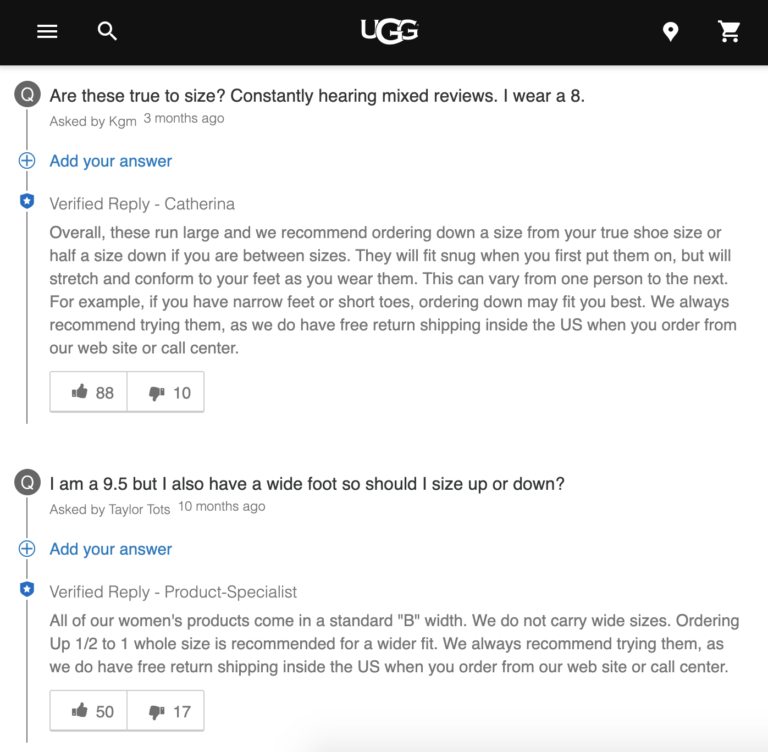
There’s a 150% lift in conversion among visitors who take this action. This is up significantly from 2020, when there was a 111.8% lift in conversion among visitors who clicked “add your answer.”
Ask Question Snippet
On some brand and retailer sites, shoppers see an overview – or “snippet” – at the top of product pages. This snippet provides shoppers with a high-level overview of the UGC available for that particular item, and it may include a link a visitor can click to submit their own question.
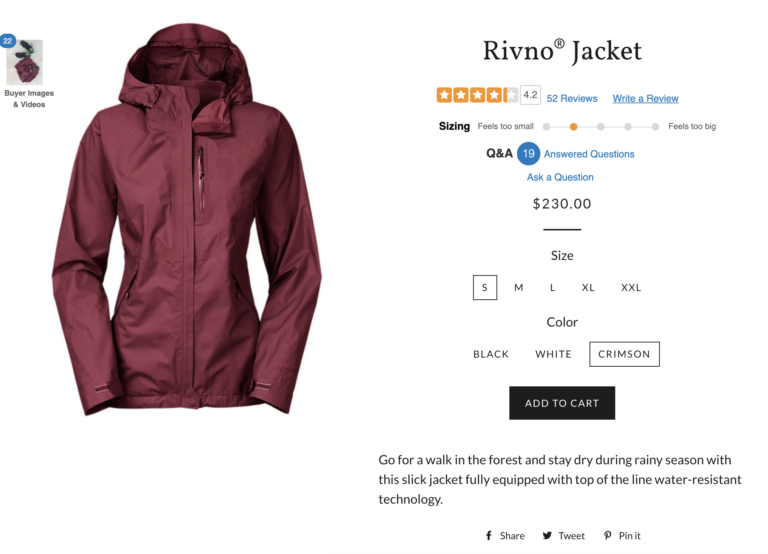
Visitors who click on “Ask a Question” in the UGC snippet convert at a rate that’s 139.3% higher than average. This is up slightly from a 137.1% lift in conversion among visitors who took this action in 2020.
Ask Question Header
Visitors can also submit questions by clicking or tapping the “Add a Question” button that’s part of the Q&A header.
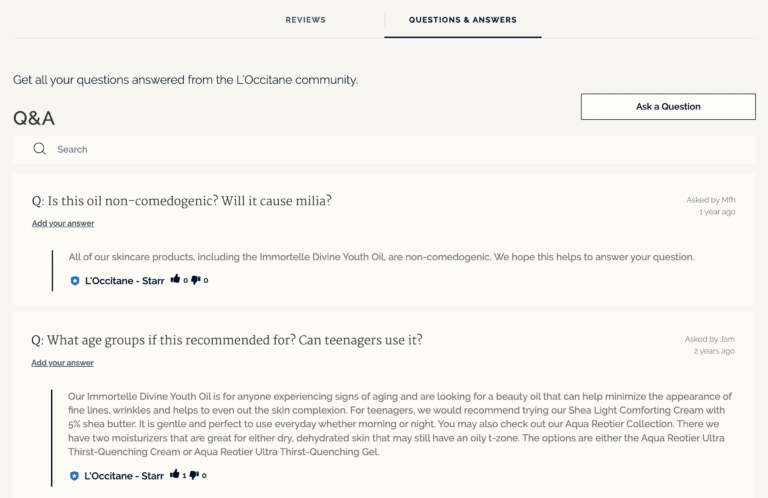
In 2021, there was a 100% increase in conversion among visitors who clicked “Add a Question” from the Q&A header, compared to a 79.4% lift among those who took the same action in 2020.
How User-Generated Imagery Impacts Purchase Behavior
Shoppers Who Interact With User-Generated Visual Content are (a Lot) More Likely to Convert
During 2021, the overall conversion rate across the brand and retailer sites we analyzed was 2.8%. However, that rate is significantly higher among visitors who interact with user-generated photos and videos on a product page: 5.9%. That’s a huge 106.3% lift in conversion.
User-generated visual content continues to have an increasingly large impact on conversion. For the sake of comparison, there was a 91.4% lift in conversion among visitors who interacted with this content in 2020.
How Various Interactions with User-Generated Visual Content Boost Conversion
There’s no denying that those who interact with photos and videos submitted by other consumers are a lot more likely to make a purchase Now, let’s explore how different types of visual content interactions impact conversion.
Image Gallery
Once you’ve started to collect photos and videos from your shoppers, it’s a best practice to showcase it in a visual content gallery on the appropriate product page. Our analysis found there’s a 110.7% conversion lift among shoppers who click on any image within such a gallery – up from a 94.1% lift in 2020.
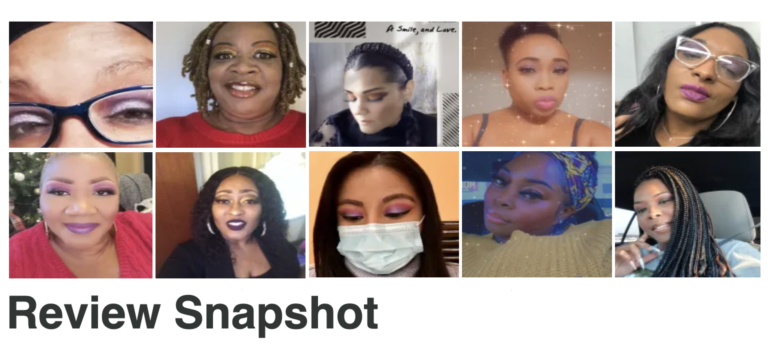
Image Gallery Navigation
Once a visitor has clicked on an image or video in an imagery gallery to enlarge it, they typically have the option to navigate to other imagery by clicking on the forward and back arrows.
There’s a 103.6% lift in conversion among visitors who click to see the next image. The conversion lift is 96.4% among those who click the arrow to view the previous image.
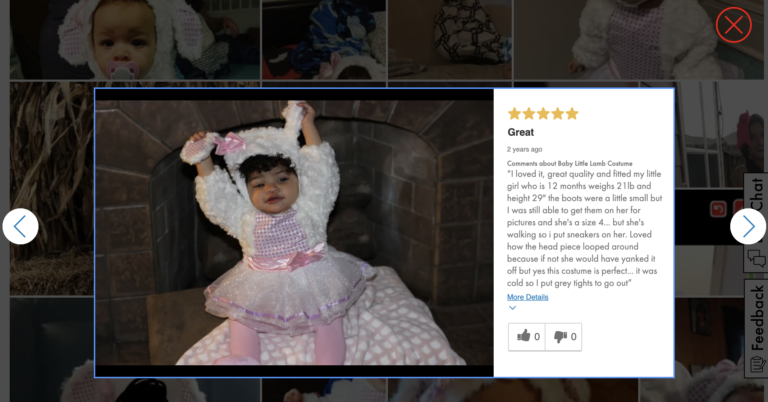
Notably, both forward and back navigation in the image gallery had a larger impact on conversion in 2021 than they did in 2020.
5 Key Takeaways
The impact of UGC can no longer be denied. Modern consumers expect it, regardless of what they’re shopping for. And those who interact with it are more likely to make a purchase.
Here are our 5 key takeaways from our latest analysis.
If a shopper scrolls a product page long enough to be served up some form of UGC, there’s a 8.5% lift in conversion. The impact is significantly higher – 100.6% – among visitors who interact with user-generated content.
UGC is no longer optional. It’s essential for any brand or retailer looking to grow sales in an increasingly competitive market. If you’re not already collecting and displaying this content, you’re leaving money on the table.
There’s risk involved with purchasing a product online, sight unseen. However, reviews can help shoppers overcome this risk – and increase the likelihood they’ll make a purchase. In fact, there’s a 108.3% lift in conversion among shoppers who interact with reviews on product pages.
Start collecting reviews. And prominently showcase this content so it’s easy to find and consume, whether a shopper is using a computer or their mobile device. In addition, consider adding features and functionality to your review display that make it easy for your shoppers to sift through content to find the reviews that are most relevant to them.
Online shoppers don’t have the opportunity to ask questions and get recommendations from an in-store associate. Instead, many turn to the Q&A portion of a product page to read questions that have already been submitted – and pose their own.
There’s a 194.2% lift in conversion when shoppers interact with Q&A content, making it the type of UGC that has the largest conversion impact.
It’s essential to provide online shoppers with a means to get answers to outstanding questions. Add a Q&A section to your product pages, and be sure to equip it with plenty of features that make it easy for shoppers to sift through existing questions – and ask their own.
A growing number of consumers specifically seek out visual content from other shoppers before making a purchase. And this content has a large (and growing) impact on conversion. There’s a 106.3% lift in conversion among visitors who interact with imagery submitted by shoppers – which is up from a 91.4% lift the year prior.
If you’re not already, start collecting photos and videos from your shoppers, both natively and via Instagram. Then, showcase it in a visual content gallery on your product pages that’s easy to find and navigate.
Throughout this report, we’ve explored the features of UGC that have the largest impact on conversion overall. However, it’s important to remember there’s no “one size fits all” UGC display that’ll work for all businesses. Rather, a feature that’s a powerful conversion-driver for one brand may have very little impact for another.
As such, it’s essential to continuously measure the performance of your UGC program. Your UGC partner should make it easy to determine which UGC features are driving conversion – and which aren’t. You can use those insights to make impactful changes to your display that’ll help you drive an even larger lift in conversion – and help you grow your sales and market share.

